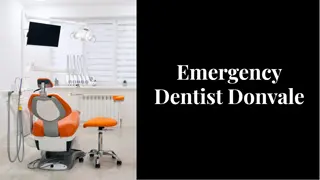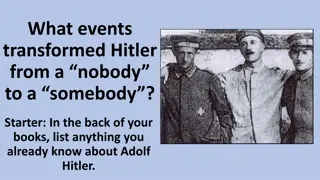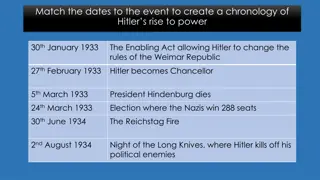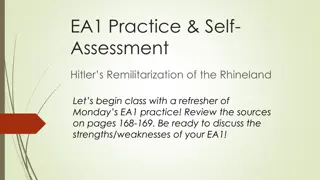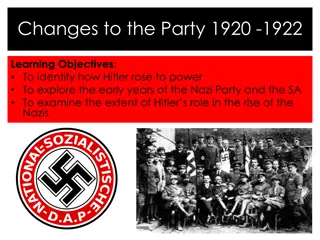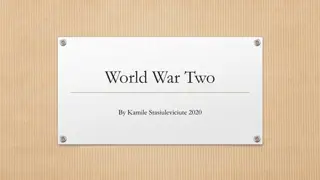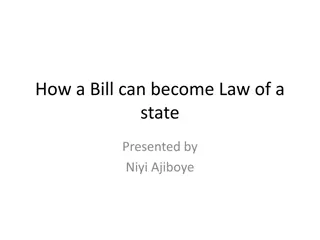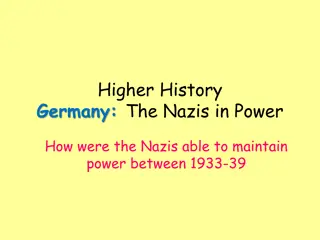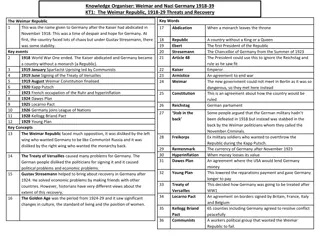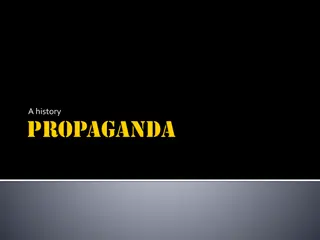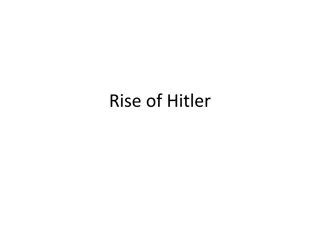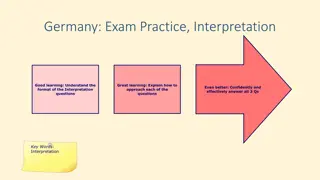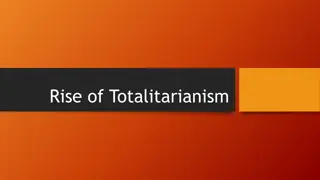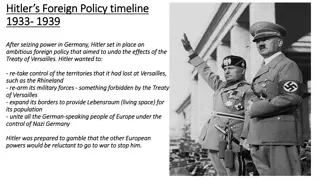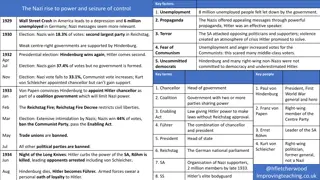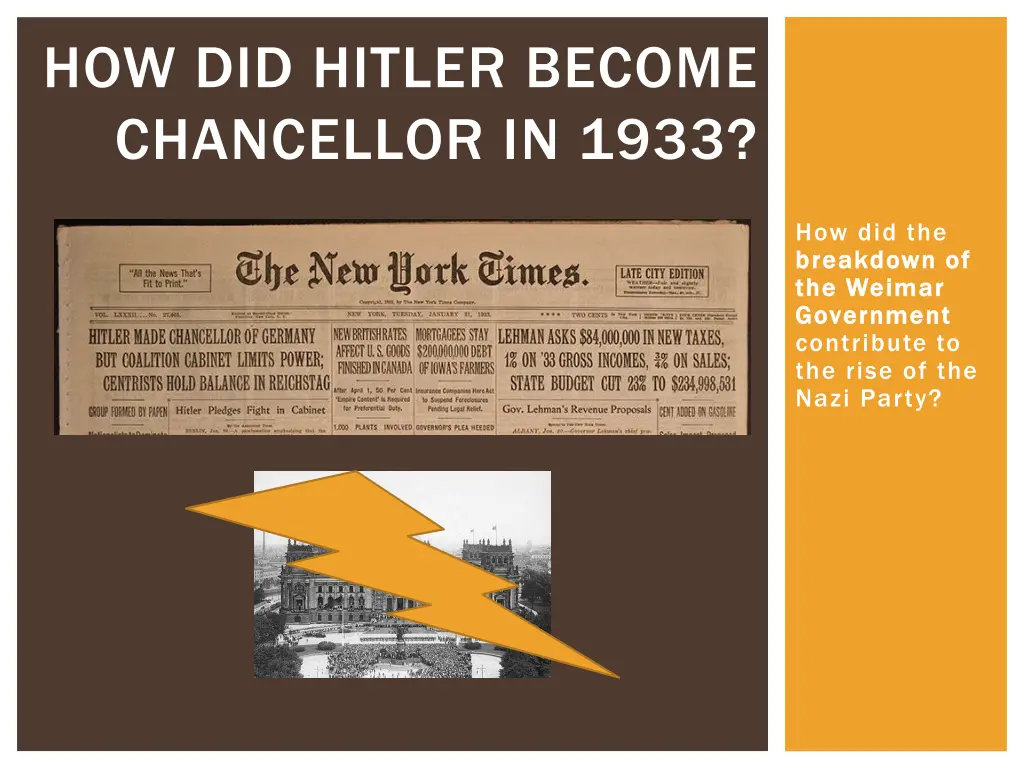
Rise of Hitler and the Fall of Weimar Government in 1933
Learn how the breakdown of the Weimar Government in the early 1930s paved the way for Hitler's rise to power as Chancellor in 1933, highlighting key events like Stresemann's death, Brüning's chancellorship, the misuse of emergency powers, the decline of democracy, and Hindenburg's critical role. Understand the political crisis that led to a loss of faith in democracy and the subsequent appointment of Franz von Papen before Hitler's ascent to power.
Download Presentation

Please find below an Image/Link to download the presentation.
The content on the website is provided AS IS for your information and personal use only. It may not be sold, licensed, or shared on other websites without obtaining consent from the author. If you encounter any issues during the download, it is possible that the publisher has removed the file from their server.
You are allowed to download the files provided on this website for personal or commercial use, subject to the condition that they are used lawfully. All files are the property of their respective owners.
The content on the website is provided AS IS for your information and personal use only. It may not be sold, licensed, or shared on other websites without obtaining consent from the author.
E N D
Presentation Transcript
HOW DID HITLER BECOME CHANCELLOR IN 1933? How did the breakdown of breakdown of the Weimar the Weimar Government Government contribute to the rise of the Nazi Party?
DEMOCRACY STARTS TO CRACK In October 1929 Stresemann died. Under his leadership, and during his time as Foreign Minister, there had been relative stability in Weimar. Stresemann In 1930 President Hindenburg appointed Heinrich Br ning as Chancellor. The Reichstag became split over policies. Br ning
TROUBLE IN WEIMAR REPUBLIC For the next two years Br ning and his advisers tried to govern without a majority vote. without a majority vote. He asked Hindenburg to use his emergency powers powers to pass laws without them having to go through the Reichstag. emergency Between 1930-32 the Reichstag sat less often and became more and more helpless.
RESULT OF POLITICAL CRISIS Laws issued using Article 48 Reichstag: Days sitting 1930: 5 1931: 44 1932: 66! 1930: 94 1931: 42 1932: 13
RESULT? Democratic parties could not agree on how to deal with Germany s problems. Most people lost faith in democracy. lost faith in democracy. Reichstag became less and less democratic. DICONTENT GREW
WEIMAR POLITICIANS 1932 Franz von Papen replaced Br ning as Chancellor. Only lasted 6 months! Von Papen struggled as he had no majority no majority in the Reichstag and relied entirely on Presidential decree. Franz von Papen
PRESIDENT HINDENBURG Elected as President twice. Was re-elected in 1932, mainly with the support of those who saw him as a protection against Nazi lawlessness and brutality. By 1932 was old man- 85 85! President Hindenburg
PAUL VON HINDENBURG He feared that Hitler was a threat to democracy. threat to democracy. Wrote to Hitler a cabinet led by you would develop into a dictatorship . Yet, Hindenburg's own supporters thought the Nazis could be useful - albeit unpleasant and were worth accommodating.
HINDENBURG The Nazis were now the largest party in the Reichstag with 37% of vote. Hitler was now in a position to demand the Chancellorship of the Reichstag. Hindenburg refused and Hitler declared that he would not bring his party into a Government for anything less than himself as Chancellor. Despite considerable pressure, Hindenburg refused to appoint him. to appoint him. Hindenburg refused
VON PAPEN & HITLER Nazis won 230 seats out of 608 in 1932. Became very useful to von Papen, hoped he could control Hitler and use Nazi support to increase his own power. In six months we ll have pushed Hitler so far into a corner he will be squealing. Offered Hitler the job of Vice Chancellor. Hitler refused, did not want to be linked to Von Papen s failing system.
HITLERS RISE TO POWER Von Papen had enemies. General Kurt von Schleicher replaced him as chancellor in 1932 (lasted 2 months!) He tried to limit the activities of the Nazi Party, in return the Nazi s allied themselves with von Papen s party to defeat von Schleicher in the Reichstag.
HITLERS RISE TO POWER With support from industrial leaders, von Papen persuaded Hindenburg to appoint Hitler as Chancellor. Hitler became Chancellor on the 30th January, 1933.
RISE TO POWER Hitler in full control? Few Nazi s in coalition government. Hindenburg had the power to get rid of Hitler at any time.

